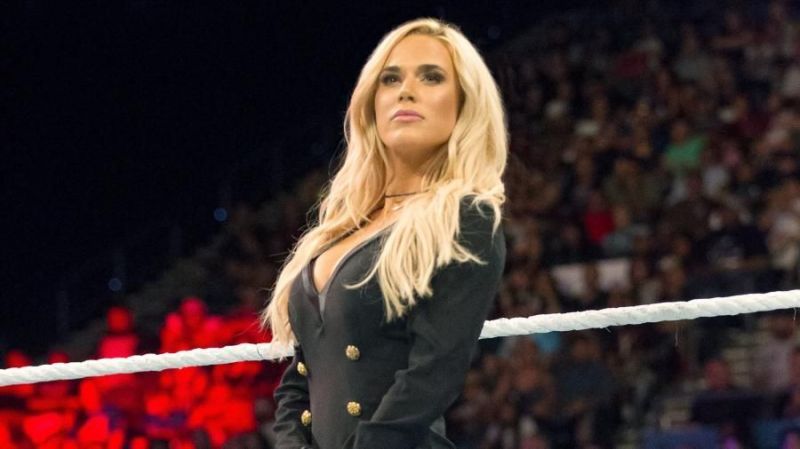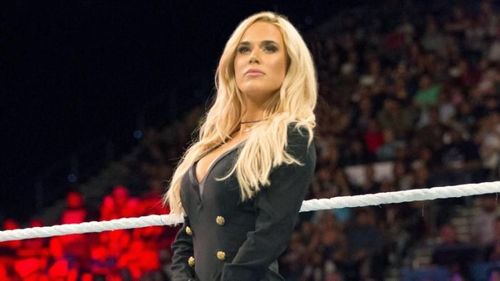
Goodbye Lenin: the tale of the Ravishing Russian

Brigitte Nielsen’s immaculate portrayal of an elite Soviet athlete’s wife and co-manager in Sylvester Stallone’s Cold War sporting drama Rocky IV was a triumph in creating an indelible female role in a largely male-oriented action film.
Stallone, who reportedly wrote the part of Ludmilla especially for Nielsen - some twenty years before inducting Hulk Hogan into the WWE Hall of Fame - cast her as an icy, yet devoted companion to the punishing super-athlete Ivan Drago.
Thus, a decade before 007's Xenia Onatopp, the image of the beautiful, driven, professional Russian woman was given modern form, and it is this trope WWE so excellently channelled to distil the character of “The Ravishing Russian” Lana, portrayed by C.J. Perry (Pitch Perfect, Sisters).
A fitness-model like Nielsen, Perry was perhaps ideally suited to the role after having previously lived in the former Latvian Soviet Socialist Republic where she was classically trained in ballet at the National Conservatoire. The tone of her accent granted Lana an authenticity which audiences everywhere seemed to connect with.
Her charge, Rusev (played by former Bulgarian power-lifter Miroslav Barnyashev) while not presented as merciless as Dolph Lundgren’s Drago, was once considered to be a top contender in the world of Sports Entertainment where he currently seems to be enjoying a renaissance in fan support today.
Sports Entertainment, as any theatrical presentation, relies on it’s archetypes. The Patriot, the evil Sheikh, the Million-Dollar Man, the Anti-Immigration heel, the Working-class hero and many others are genre staples and the power of using Ludmilla as a template to mould Lana, was instant recognition.
It had been almost 30 years since the dissolution of Lenin's dream under the Premiership of Mikhail Gorbachev yet the idea of the ruthless Soviet power-couple registered immediately with fans.
Much like Nielsen and Stallone before them, news of a relationship between Perry and Barnyashev was perhaps expected by some. The tradition of female valet’s entering into actual off-screen relationships with their clients is as long and storied as the severe WWE travel schedule that often brings them together.
Yet, there seemed to be an air of genuine romance between the two and this translated into some of the better character-driven moments on recent WWE television, particularly Lana’s echo of Ludmilla’s catch-phrase from the movie evolving into “Rusev, Crush!”
For some reason, shortly after the relationship was confirmed and before this chemistry could be fully realised on TV, the characters were separated in hasty and poorly scripted fashion. The powerful and authoritative aspects so integral to Ludmilla - which had been building with Lana for months - were made to look weak and ineffectual in a few short on-screen moments with the Stephanie McMahon character.
The Commissioner of Monday Night Raw appears to trump virtually everyone and everything at all times, thus preventing any other superstar from appearing suitably imposing - a flaw also widely reflected upon by long-serving commentators such as POST Wrestling's John Pollock and Jason Solomon on his popular "Sound Off" Podcast.
Further dilution came, when, for no substantial reason, Lana was written to raze her assertive image and start dancing in casual attire for the entrance of her new client and boyfriend - a character partially based on Boogie Night's Dirk Diggler, in a soap-opera twist Rolling Stone awarded “Worst Storyline Of the Year”.
Thus, the only stand-out female non-competitor character on WWE programming, and the only one who had so wonderfully evoked an enduring cinematic character from the 1980s, was reduced to being the same as nearly every other female performer on the card.
Sometime later, for no apparent reason, Lana reconciled with Rusev but the radical change-and-back did not make any sense from a character standpoint, let alone story. This does not mean either remain perpetually barred from evolving beyond the Soviet-heel stereotype, but even soap-opera's must make some sense.
Today the Lana character is being presented as a dancer liberated following a brush with feminism, occasionally acting as a cheerleader for Rusev, but this does not help her remain distinctive in a locker-room full of women whose greater ring experience leaves them far more convincing.
With the successful 80's nostalgia of Stranger Things, GLOW and a new Karate Kid series featuring the original cast, perhaps a Nielsen cameo opposite Lana might have been more relevant creatively.
The decision to have Perry assume an in-ring role instead of managing has taken her further away from her core strengths, while depriving the Rusev character of the same natural sympathy Elizabeth once helped to inspire for a frenetic Randy Savage.
Covered in the pages of Sports Illustrated and USA Today, as a manager, Lana enjoyed a uniquely commanding introduction and entrance, however the decidedly ditzy role portrayed by Perry for E!’s ‘scripted-reality’ Total Divas series has perhaps ensured she is never taken seriously in the role of the well-heeled foreign manager ever again.
The treatment of Lana is symptomatic of how, WWE no longer allows it’s stars to seem larger-than-life any more. Whereas once personalities such as Dwayne "The Rock" Johnson, Hulk Hogan, Roddy Piper, Steve Austin, Bret "The Hitman" Hart, Brian Pillman, Kurt Angle, Scott Hall, Kevin Nash and Chris Jericho would break all the rules and create drama, now there is an ensemble cast that dutifully follows everything by-the-book - and it has nothing to do with the product being PG. T
he last real outlaws were Phil "CM Punk" Brooks who left the company in 2014 to fight for UFC, Gail Kim (who's stupefying absence from the inaugural women's Royal Rumble defies explanation) and Cody Rhodes, who went on to star in the acclaimed Warner Bros./DC Comics series Green Arrow whilst simultaneously becoming the most sought-after free-agent performer of his generation.
Since WWE does not follow any particular dramatic or narrative structure, audience investment remains minimal. Broadcast viewership in the United States has been in a steady decline for the past 17 years and recent figures appear to show the streaming WWE network to have seemingly stalled at approximately 1.5 million subscribers.
While Forbes and Business Insider correctly identify this figure as a runaway success for the company both in terms of market-leading distribution and profitability, the audience for Wrestling has historically proved to be much larger.
Boasting some 40m Facebook Likes, 20m YouTube Subscribers, 15m Instagram Followers, and 10m Twitter Followers who generate billions of unique Social Media impressions every week, the brand has converted less than 1% of these to paid subscriptions.
Due to the McMahon family's stubborn dedication to good causes, the corporation continues to make a life-changing difference in the lives of thousands of people across the world (particularly children and veterans) with the individual generosity of stars such as Titus O'Neil and Heath Slater often going unreported.
While revenue remains enviably handsome, the vast majority of the audience is sadly drifting away. The explosion in independent wrestling worldwide such as Scotland's ICW, demonstrates fans are finding alternatives and hopefully this might inspire the company - with the grateful exception of Triple H and William Regal's work in NXT - to treat their characters with greater integrity in order to tell more coherent stories. Certainly, they could make much more of a beautifully skilled and talented performer such as Perry.
Send us news tips at fightclub@sportskeeda.com